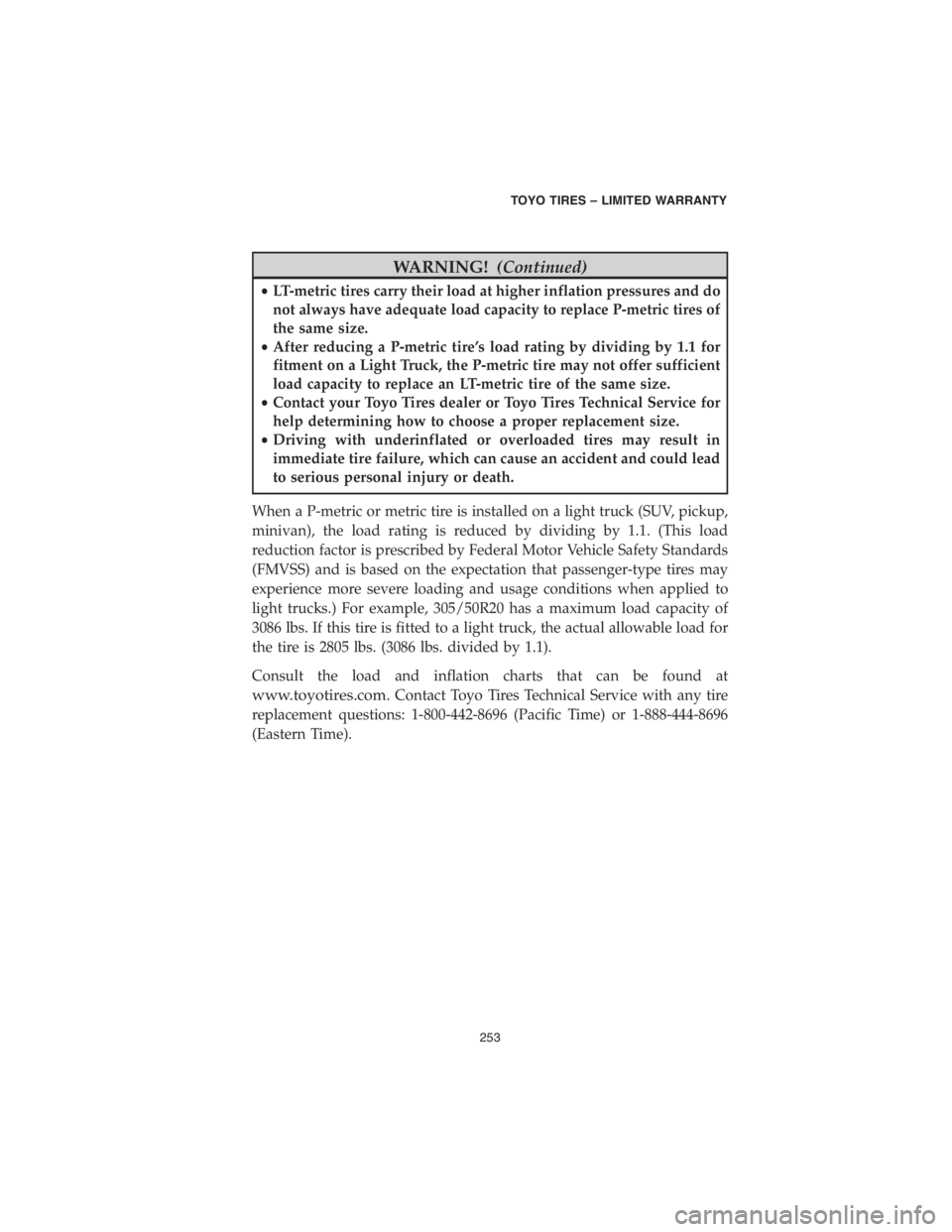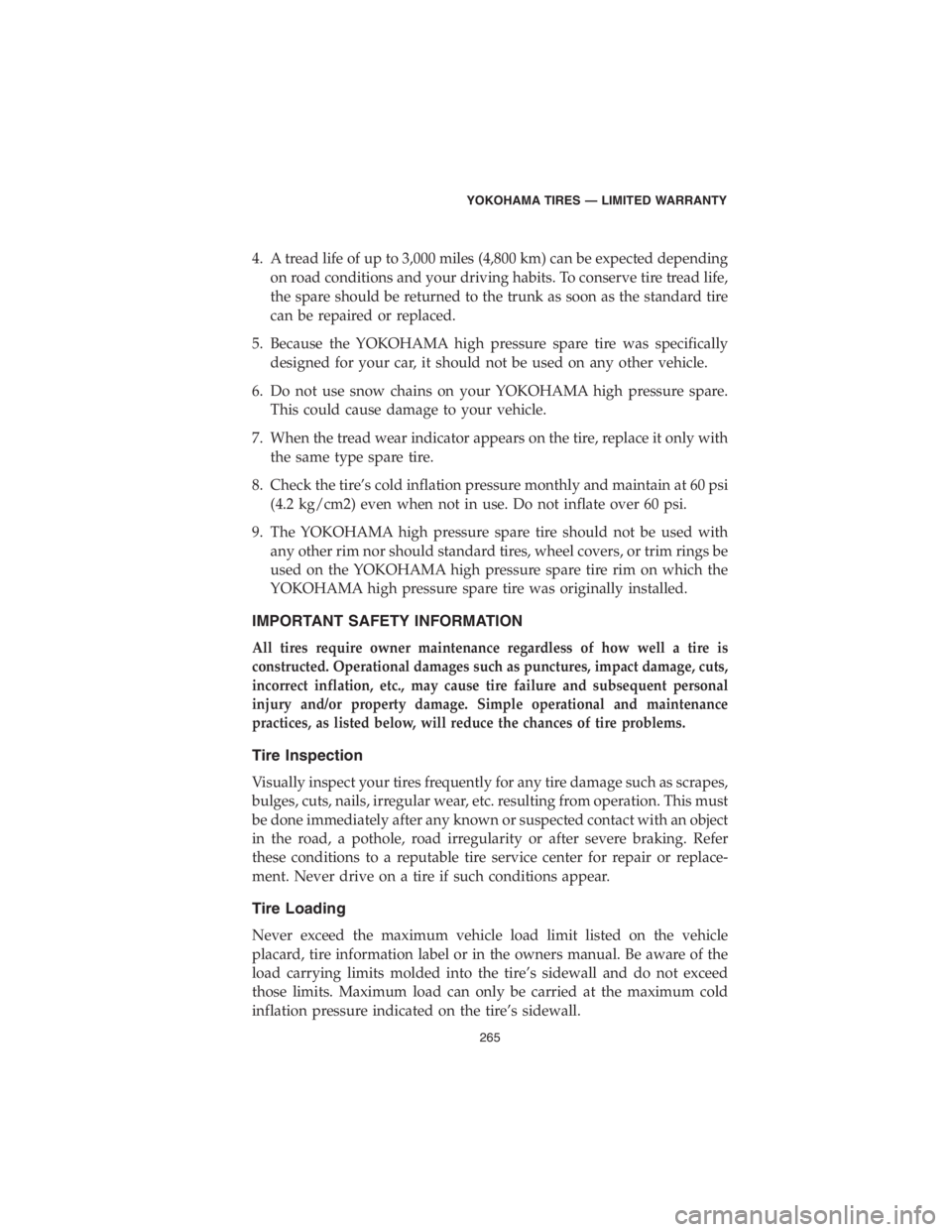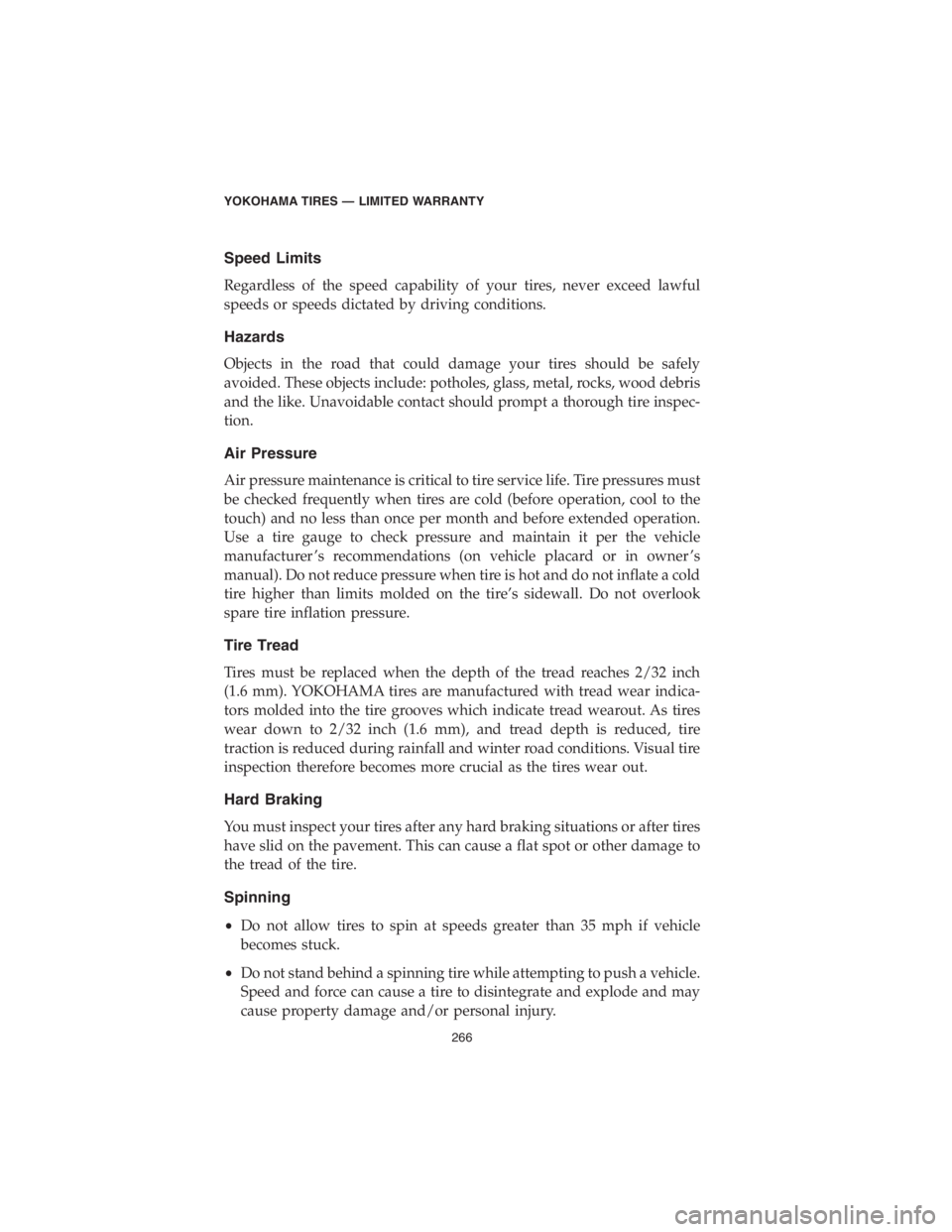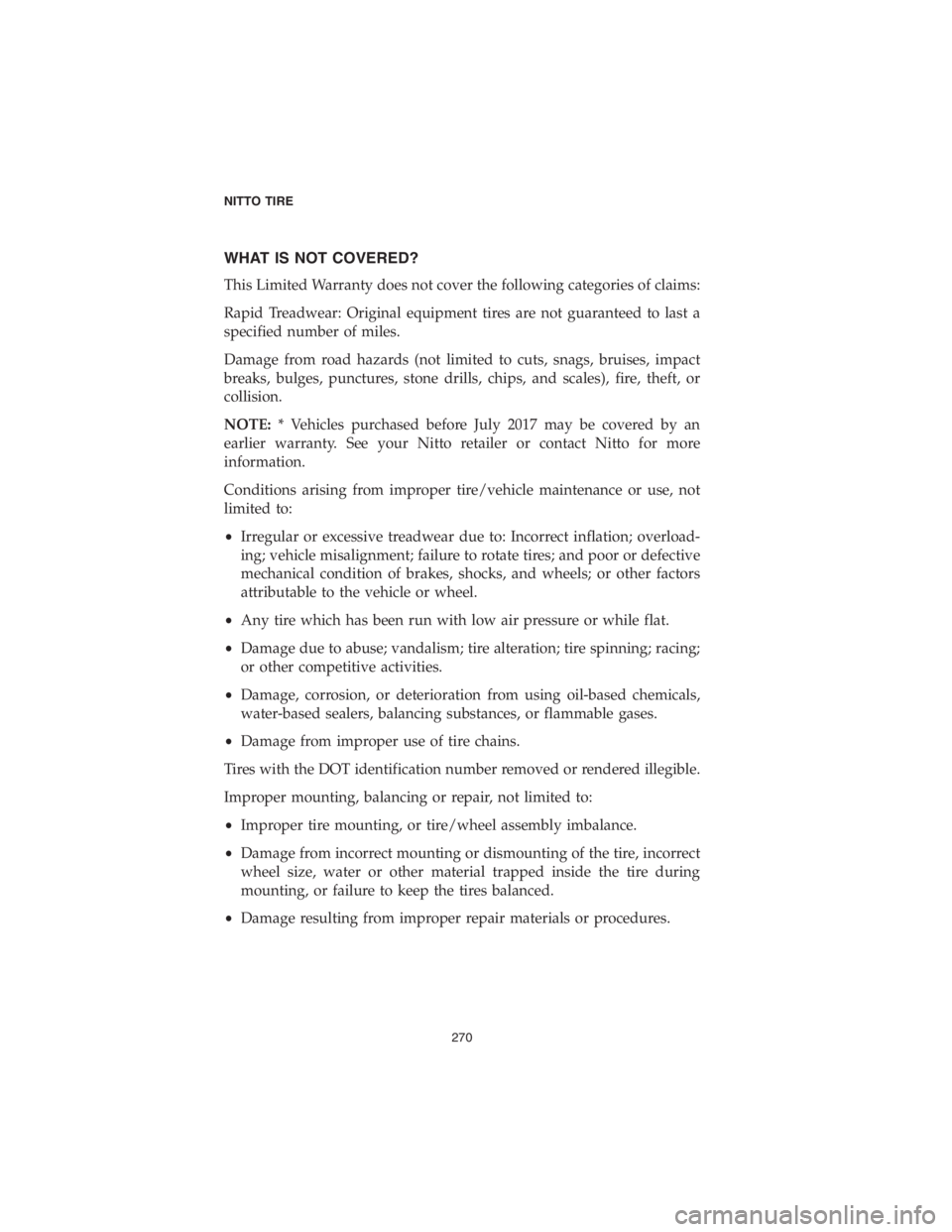Page 253 of 316
speeds in excess of 65 mph may be required, then the following
adjustments or recommendations should be followed:
•At speeds from 66 mph through 75 mph, cold inflation pressure must
be increased 10 psi above the recommended pressures for the load
being carried.
•Do not exceed the maximum inflation pressure of the wheel (all wheels
have maximum allowable inflation pressures).
REPLACEMENT TIRES FOR LIGHT TRUCKS – P-METRIC VS .
LT-TRUCK
Tire installers should exercise extreme caution when replacing tires on
light trucks.
The maximum load capacity stamped on the sidewall of a P-metric tire is
reduced by a factor of 1.1 when used on a light truck, a sport utility
vehicle, or a trailer.
WARNING!
•P-metric and LT-metric tires are not necessarily interchangeable.
P-metric and LT-metric tires follow completely different Load/
Inflation tables and are designed to carry different loads at
different pressures.
(Continued)
TOYO TIRES – LIMITED WARRANTY
252
Page 254 of 316

WARNING!(Continued)
•LT-metric tires carry their load at higher inflation pressures and do
not always have adequate load capacity to replace P-metric tires of
the same size.
•After reducing a P-metric tire’s load rating by dividing by 1.1 for
fitment on a Light Truck, the P-metric tire may not offer sufficient
load capacity to replace an LT-metric tire of the same size.
•Contact your Toyo Tires dealer or Toyo Tires Technical Service for
help determining how to choose a proper replacement size.
•Driving with underinflated or overloaded tires may result in
immediate tire failure, which can cause an accident and could lead
to serious personal injury or death.
When a P-metric or metric tire is installed on a light truck (SUV, pickup,
minivan), the load rating is reduced by dividing by 1.1. (This load
reduction factor is prescribed by Federal Motor Vehicle Safety Standards
(FMVSS) and is based on the expectation that passenger-type tires may
experience more severe loading and usage conditions when applied to
light trucks.) For example, 305/50R20 has a maximum load capacity of
3086 lbs. If this tire is fitted to a light truck, the actual allowable load for
the tire is 2805 lbs. (3086 lbs. divided by 1.1).
Consult the load and inflation charts that can be found at
www.toyotires.com. Contact Toyo Tires Technical Service with any tire
replacement questions: 1-800-442-8696 (Pacific Time) or 1-888-444-8696
(Eastern Time).
TOYO TIRES – LIMITED WARRANTY
253
Page 266 of 316

4. A tread life of up to 3,000 miles (4,800 km) can be expected depending
on road conditions and your driving habits. To conserve tire tread life,
the spare should be returned to the trunk as soon as the standard tire
can be repaired or replaced.
5. Because the YOKOHAMA high pressure spare tire was specifically
designed for your car, it should not be used on any other vehicle.
6. Do not use snow chains on your YOKOHAMA high pressure spare.
This could cause damage to your vehicle.
7. When the tread wear indicator appears on the tire, replace it only with
the same type spare tire.
8. Check the tire’s cold inflation pressure monthly and maintain at 60 psi
(4.2 kg/cm2) even when not in use. Do not inflate over 60 psi.
9. The YOKOHAMA high pressure spare tire should not be used with
any other rim nor should standard tires, wheel covers, or trim rings be
used on the YOKOHAMA high pressure spare tire rim on which the
YOKOHAMA high pressure spare tire was originally installed.
IMPORTANT SAFETY INFORMATION
All tires require owner maintenance regardless of how well a tire is
constructed. Operational damages such as punctures, impact damage, cuts,
incorrect inflation, etc., may cause tire failure and subsequent personal
injury and/or property damage. Simple operational and maintenance
practices, as listed below, will reduce the chances of tire problems.
Tire Inspection
Visually inspect your tires frequently for any tire damage such as scrapes,
bulges, cuts, nails, irregular wear, etc. resulting from operation. This must
be done immediately after any known or suspected contact with an object
in the road, a pothole, road irregularity or after severe braking. Refer
these conditions to a reputable tire service center for repair or replace-
ment. Never drive on a tire if such conditions appear.
Tire Loading
Never exceed the maximum vehicle load limit listed on the vehicle
placard, tire information label or in the owners manual. Be aware of the
load carrying limits molded into the tire’s sidewall and do not exceed
those limits. Maximum load can only be carried at the maximum cold
inflation pressure indicated on the tire’s sidewall.
YOKOHAMA TIRES — LIMITED WARRANTY
265
Page 267 of 316

Speed Limits
Regardless of the speed capability of your tires, never exceed lawful
speeds or speeds dictated by driving conditions.
Hazards
Objects in the road that could damage your tires should be safely
avoided. These objects include: potholes, glass, metal, rocks, wood debris
and the like. Unavoidable contact should prompt a thorough tire inspec-
tion.
Air Pressure
Air pressure maintenance is critical to tire service life. Tire pressures must
be checked frequently when tires are cold (before operation, cool to the
touch) and no less than once per month and before extended operation.
Use a tire gauge to check pressure and maintain it per the vehicle
manufacturer ’s recommendations (on vehicle placard or in owner ’s
manual). Do not reduce pressure when tire is hot and do not inflate a cold
tire higher than limits molded on the tire’s sidewall. Do not overlook
spare tire inflation pressure.
Tire Tread
Tires must be replaced when the depth of the tread reaches 2/32 inch
(1.6 mm). YOKOHAMA tires are manufactured with tread wear indica-
tors molded into the tire grooves which indicate tread wearout. As tires
wear down to 2/32 inch (1.6 mm), and tread depth is reduced, tire
traction is reduced during rainfall and winter road conditions. Visual tire
inspection therefore becomes more crucial as the tires wear out.
Hard Braking
You must inspect your tires after any hard braking situations or after tires
have slid on the pavement. This can cause a flat spot or other damage to
the tread of the tire.
Spinning
•Do not allow tires to spin at speeds greater than 35 mph if vehicle
becomes stuck.
•Do not stand behind a spinning tire while attempting to push a vehicle.
Speed and force can cause a tire to disintegrate and explode and may
cause property damage and/or personal injury.
YOKOHAMA TIRES — LIMITED WARRANTY
266
Page 271 of 316

WHAT IS NOT COVERED?
This Limited Warranty does not cover the following categories of claims:
Rapid Treadwear: Original equipment tires are not guaranteed to last a
specified number of miles.
Damage from road hazards (not limited to cuts, snags, bruises, impact
breaks, bulges, punctures, stone drills, chips, and scales), fire, theft, or
collision.
NOTE:* Vehicles purchased before July 2017 may be covered by an
earlier warranty. See your Nitto retailer or contact Nitto for more
information.
Conditions arising from improper tire/vehicle maintenance or use, not
limited to:
•Irregular or excessive treadwear due to: Incorrect inflation; overload-
ing; vehicle misalignment; failure to rotate tires; and poor or defective
mechanical condition of brakes, shocks, and wheels; or other factors
attributable to the vehicle or wheel.
•Any tire which has been run with low air pressure or while flat.
•Damage due to abuse; vandalism; tire alteration; tire spinning; racing;
or other competitive activities.
•Damage, corrosion, or deterioration from using oil-based chemicals,
water-based sealers, balancing substances, or flammable gases.
•Damage from improper use of tire chains.
Tires with the DOT identification number removed or rendered illegible.
Improper mounting, balancing or repair, not limited to:
•Improper tire mounting, or tire/wheel assembly imbalance.
•Damage from incorrect mounting or dismounting of the tire, incorrect
wheel size, water or other material trapped inside the tire during
mounting, or failure to keep the tires balanced.
•Damage resulting from improper repair materials or procedures.
NITTO TIRE
270
Page 277 of 316
IMPORTANT SAFETY INFORMATION
This manual is not intended to provide proper training or service
procedures for tire mounting, dismounting, balancing, rotation, or
repair. Please leave these tasks to qualified tire service professionals.
mNOTICE!
Nitto brand tires are designed and built with great care. Any tire, no matter
how well constructed, can fail as a result of punctures, impact damage,
underinflation/overloading or other conditions resulting from use. Tire
failures may create a risk of property damage or personal injury. To obtain the
highest possible performance, tires must be maintained properly.
Remember, you are ultimately responsible for the tires installed on your
vehicle.
Important factors in tire care are:
•Proper inflation pressure
•Proper vehicle loading
•Proper vehicle maintenance
•Regular inspection
•Good driving habits
Refer to your vehicle Owner ’s Manual for additional tire safety and
service advice.
NITTO TIRE
276
Page 278 of 316
TIRE PRESSURE BASICS
The combined effect of losing 1 psi per month over several months along
with a 1 psi decrease for every 10°F temperature drop could add up to a
severe “run low” condition; consequently, it is important to check your
tires’ inflation pressure at least once per month.
Inflation pressure enables a tire to support its load; therefore, proper
inflation is critical.
HOW TO DETERMINE PROPER TIRE INFLATION PRESSURE
It is impossible to determine whether tires are properly inflated just by
looking at them.
25 PSI
NITTO TIRE
277
Page 280 of 316
It is important to check your tires using an accurate tire pressure gauge,
which can be purchased at your tire dealer or auto supply store.
Underinflation can overload tires. Check the inflation pressure every
month, including for the spare tire, to make sure it’s up to specification.
Check it again before long trips or when carrying extra weight.
Look for the manufacturer ’s recommended inflation pressure listed on
the Tire Information Placard usually located on your vehicle’s door edge,
door post, glove box, or inside the trunk lid.
mNOTICE!
The inflation pressure shown on the sidewall of the tire is not the intended
inflation pressure for the vehicle! Always refer to the vehicle’s Tire
Information Placard.
NITTO TIRE
279